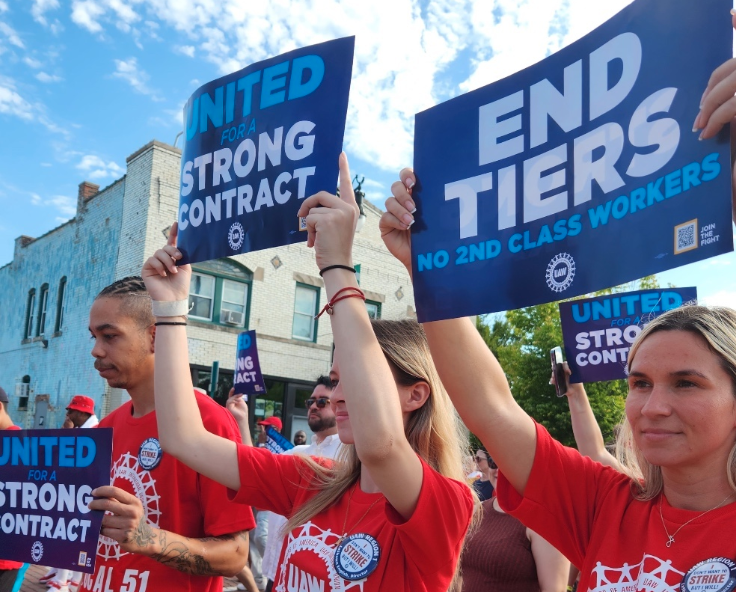NEWS
UAW Strike Against Big 3 Automakers Looks Increasingly Likely When Contract Ends Sept. 15
Published
11 months agoon

Courtesy of @uaw.union via Instagram
A major strike by workers at Detroit’s “Big 3” automakers — General Motors, Ford and Stellantis — appears increasingly likely when their contract ends on Sept. 14.
United Auto Workers, which represents nearly 150,000 auto workers at the Big 3, is demanding double-digit wage increases, more paid time off, and increased retiree pay, along with the restoration of benefits the workers once had, including pensions, retiree medical benefits and cost of living adjustments.
According to the UAW, GM, Ford and Stellantis made a combined $21 billion in profits in the first six months of 2023, after raking in $250 billion in North American profits over the last decade.
“So what have the Big 3 done with these staggering profits? Instead of rewarding the workers who spent long hours wrecking their bodies on the line to make these profits possible, the Big 3 have funneled billions into stock buyback schemes that artificially inflate the value of company shares,” UAW President Shawn Fain said in a video message to members last month.
“Record profits mean record contracts,” Fain said.
“Yes, we’re demanding double-digit pay raises,” the UAW said in a statement. “Big Three CEOs saw their pay spike 40 percent on average over the last four years. We know our members are worth the same and more.”
The union is also demanding the end of lower-paid employment tiers, a concession the Teamsters recently won in their recent contract with UPS, a deal that was reached under the threat of a strike.
The UAW is also seeking the right to strike over plant closures, and the “working family protection program,” which would have automakers pay workers to do community service work if their company leaves town.
Last week, the union filed unfair labor practice charges with the National Labor Relations Board, claiming GM and Stellantis are not bargaining in good faith. The move makes a strike seem all the more likely at those two companies, if not all three.
“It’s a precarious situation because a strike by the 150,000 Ford and GM workers would potentially cause a $5 billion economic loss in just 10 days,” said Ted Jenkin, founder and CEO of Atlanta-based oXYGen Financial.
But the time may be right for workers to demand more, as a demographic shift sees more older workers leaving the workforce.
“An expanding economy and a shrinking working-age population laid the groundwork for workers to demand more from their employers,” said Bradley Schurman, founder and CEO of the demographic strategy firm, The Super Age, which helps public and private-sector organizations navigate disruptive population change.
“During the pre-pandemic years, labor was abundant,” Schurman said. But baby boomers, the generation born in the mid-20th century, began leaving the workforce en masse during the pandemic, sparking a worker shortage, he said.
“At their peak, boomers numbered 76 million people. However, Gen Z only accounts for 69 million people, a differential of 7 million people. There are too few workers, given that demand is outstripping supply, giving unions an opening for collective action that they haven’t had since the 1950s,” Schurman said.
“Collective action can disrupt the economy and daily life, stoking inflation and the cost of living. However, it can also narrow the wage gap, which has widened for decades,” Schurman said. “The UAW demands may seem outlandish, but they are a negotiation starting point.”
TMX contributed to this article.
More From Auto Overload
-


Regulators Seek Recall of 52 Million Defective Airbag Inflators Made…
-


9 Things You Should Never Leave In The Car
-


Two Essential Truths Every Car Owner Needs To Know
-


10 Common Car Problems Every Driver Should Be Aware Of
-


Federal Regulators Order Tesla To Share Data On Autopilot’s Hidden…
-


Most Major Carmakers Admit They Sell, Share Your Personal Data,…
-


11 Essential Items You Need To Keep In Your Vehicle
-


8 Easy Ways To Boost Fuel Efficiency
-


6 Popular Car Features That Will Never Be Seen Again
-


8 Easy Ways To Increase Your Car’s Value
-


6 Best High Mileage Motor Oils On The Market
-


6 Strategies To Save At The Pump

